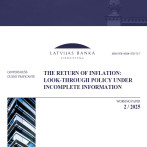Annual inflation rate approximates 3%

The rise in year-on-year inflation in January was primarily determined by increasing energy and food prices. The result was hardly a surprise – the 2016 price rises at world stock exchanges gradually found reflection in consumer prices.
In the first half of January, fuel prices continued to rise as a reflection of oil price rises in October and November of last year (oil price transmission to fuel prices takes around two months). As from the beginning of December, however, oil prices have been stable, so a significant rise in the price of fuel is not expected in February.
Natural gas price rose in January, reflecting the rise in the prices of heavy fuel oil. One does not have to be a clairvoyant to predict a rise in gas prices also in the coming months, which will also lead to a rise in heating tariffs.
The price of gas this year will be higher on average than last year, and it has nothing to do with the planned liberalization of the gas market. Yet the coincidence with said liberalization may lead to the wrong impression that it is the main factor leading to a rise in gas prices. In fact, the impact of gas market liberalization on the average annual inflation is hardly likely to exceed 0.1 percentage points; in the long term, however, market liberalization may bring down the price of gas.
In January the prices of milk and dairy products rose substantially. That, too, is hardly a surprise: world milk prices as well as milk purchase prices in Latvia rose by more than half since last spring, raising the production costs of dairy products. A few months have to pass for this to find reflection in retail prices. There is no reason for any uproar in relation to this: the prices of dairy products only returned to the level observed before the European Union-Russian trade sanctions announced in 2014.
Vegetables also appreciated substantially, as a result of the poor harvest in Spain. Yet the untypically high prices for vegetables are likely to remain in effect only for a few months – till the next season.
We can conclude that several unrelated, yet coincidental factors have acted to raise inflation in the last few months and that is why inflation rose unexpectedly fast.
Textual error
«… …»






